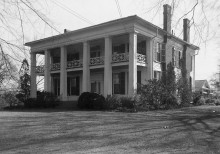Is this your ancestor? If you are an Alabama Pioneers Patron, you can Update and/or correct info in the Comments.
JOIN US
Become an Alabama Pioneers Patron – share, connect with cousins, correct and and preserve your ancestry through the comments!
WADE HAMPTON ALLEN
BIOGRAPHY and GENEALOGY
(1794 – 1851)
Montgomery, Alabama.
Wade Hampton Allen, planter and businessman, was born April 16, 1794, in Edgefield District, South Carolina, and died at Montgomery, June 21, 1851. He was the son of Robert Allen (a Revolutionary soldier) and Nancy (Hamm) Allen of Edgefield who moved to Alabama with his family around 1817 when Alabama was still a territory. Robert Allen served as a horseman under Joseph Pickens. Wade was the grandson of Hezekiah Allen, also a Revolutionary soldier, who was killed by Indians and Tories near that town. Robert Allen died in 1829, and his will mentions his wife and offspring by name.
SUPPORT ALABAMA PIONEERS
BECOME AN ALABAMA PIONEERS PATRON
Tap to see how to Become a Patron!
“Before the competing villages of New Philadelphia and East Alabama merged into the nascent city of Montgomery, an interesting observation was made in Woodward’s Reminiscences. After a lengthy diatribe recalling the formation of the infant city and how Montgomery was named, the following commentary was given as an afterthought in a letter from J.G. Klinck, dated November 24, 1858.”i
“P.S. The foregoing alludes to Dexter’s quarter section alone, up to the time stated. Walton Lucas and Mr. Allen were both doing business on the Bluff fraction in 1819, close to the river.”ii
SEE ALL BOOKS BY DONNA R CAUSEY AT https://www.amazon.com/author/donnarcausey
Wade Hampton attended Charles Barrett’s school in Edgefield, South Carolinian. In 1817, he came to Montgomery and lived in the city or its vicinity until his death. He possessed great energy and enterprise, having, besides large planting interests, a contract for carrying the mails between Montgomery and Mobile; established a stagecoach passenger business between those points; and was interested in a line of steamboats on the Alabama River.
He was a Methodist. Wade married 1st Katherine Crum Carpenter, on March 8, 1821, daughter of Dennis and Margaret (Hahm) Carpenter, early immigrants from South Carolina to Montgomery County, and 2nd Elizabeth P. Sayre, sister of William, Philemon D., and Daniel Sayre, and daughter of Calvin and Mary (Dickerson) Sayre, who lived at Morristown, N. J., the latter a niece of Gen. Philemon Dickerson, who served under Washington in the American Revolution.
The children by his first wife were:
- Ann Allen, m. Dr. Andrew McBryde,
- Eliza Allen, m. Thomas Hill Watts who was governor of Alabama 1863 to 1865,
by his second wife:
- Calvin Dickerson Allen – died at eleven months.
- William Wirt Allen m. Susan Ball; he became an infamous Confederate soldier. He was born in NY in 1835
- Charles Sayre Allen -died in infancy 1843.
- Wade Hampton Allen, died as young adult 1861
- George Edward/Edmund Allen, m. Sallie E. Given, lived and died in Montgomery;
- Joseph Virginus Allen -died as young adult 1865
- Philemon Dickerson Allen
Wade lived with his family in southwest Montgomery County, 1.8 miles north of Pintlala, on the west side of Hwy 31 at a place called Allen’s hill. He had a strong, formative influence on Methodism in Montgomery, formed on September 15, 1820, in the Union Church. He was one of three stewards of the church.
Allen was an attorney in the early city of Montgomery and served as Justice of the Peace. He was an owner and manager of stagecoaches and in 1839, he purchased for $50,000 a stage line service from Ward, Taylor and Company, the proprietors that carried mail from Montgomery to Mobile. “Allen became well-known for his efficient management of four-horse stagecoaches, exceeding the expectations for arrival time.” iii
“Early in his career as a mail carrier, he brought in partners, a Mr. Kitchens of Blakeley and a Mr. Simond from out of state.”iv
His land holdings exceeded 200,000 acres in Lowndes, Montgomery, Lee, Macon, Coosa, Chambers, Russell, Chilton, Elmore and Tallapoosa Counties, and were so extensive that he was able to feed the horses on the stage line from the produce of his fields and his slaves managed the stables at the rest stops. He also owned land in Texas.
Allen and a Mr. Pinkston shared an interest in a sawmill on Spring Creek which at the time was known as Eight Mile Creek. He supported the establishment of the Montgomery Academy, erected in 1840. Allen was involved in many numerous civic and political events, including Lafayette’s visit, bringing the capital to Montgomery and organizing early elections.
Wade H. Allen died on June 21, 1851. The Allens and the Sayres are buried in adjoining family plots in Montgomery’s Oakwood Cemetery.
SOURCES:
- History of Alabama and dictionary of Alabama biography, Volume 3 By Thomas McAdory Owen, Marie Bankhead Owen
- Alabama State Archives
- PINTLALA HISTORICAL ASSOCIATION newsletter January 20th, 2008 by Gary Burton
- Find A Grave.com # 25194564 # 25194647# 25194411# 25194300 # 10827 # 25194189 # 51640634 # 51640660
iPINTLALA HISTORICAL ASSOCIATION newsletter January 20th 2008 by Gary Burton
iiPINTLALA HISTORICAL ASSOCIATION newsletter January 20th 2008 by Gary Burton
iiiPINTLALA HISTORICAL ASSOCIATION newsletter January 20th 2008 by Gary Burton
ivPINTLALA HISTORICAL ASSOCIATION newsletter January 20th 2008 by Gary Burton
Start researching your family genealogy research in minutes. This inexpensive Ebook has simple instructions on how to get started with FREE sources. Download WHERE DO I START? Hints and Tips for Beginning Genealogists with On-line resources to your computer immediately with the FREE APP and begin your research today!
Reviews
“This book was very informative and at a very modest price. Thank you for your great newsletter and this book.”
“The book was clear & concise, with excellent information for beginners. As an experienced genealogist, I enjoyed the chapter with lists of interview questions. I’d recommend this book to those who are just beginning to work on their genealogies. For more experienced genealogists, it provides a nice refresher.”




